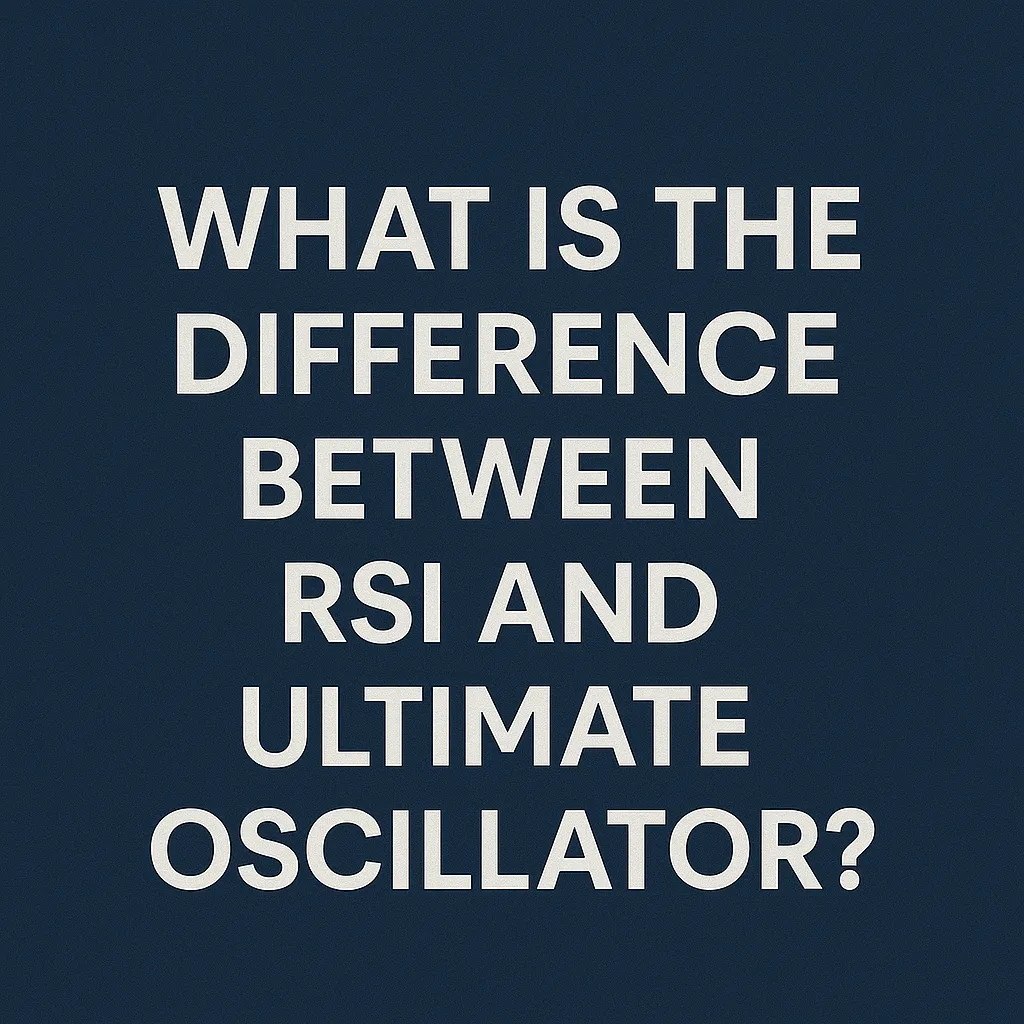When it comes to momentum indicators, two names often come up: the Relative Strength Index (RSI) and the Ultimate Oscillator (UO).
Both help traders spot overbought, oversold, and reversal opportunities — but they are very different in how they calculate and display momentum.
In this guide, you’ll learn the key differences between RSI and Ultimate Oscillator, and which one may be better for your trading strategy.
📈 Quick Overview: What is RSI?
The Relative Strength Index (RSI), developed by J. Welles Wilder, measures the speed and change of price movements over a single timeframe.
✅ Values range from 0 to 100.
✅ Standard setting = 14 periods.
✅ Above 70 = Overbought.
✅ Below 30 = Oversold.
It’s one of the most popular momentum indicators — simple, fast, and easy to read.
📈 Quick Overview: What is the Ultimate Oscillator?
The Ultimate Oscillator (UO), created by Larry Williams, tracks buying pressure across three timeframes (typically 7, 14, and 28 periods) and uses a weighted formula.
✅ Values also range from 0 to 100.
✅ Weights short-term momentum more heavily (4-2-1).
✅ Designed to reduce false signals common in single timeframe oscillators.
📊 Feature Comparison: RSI vs Ultimate Oscillator
| Feature | RSI | Ultimate Oscillator |
|---|---|---|
| Created By | J. Welles Wilder | Larry Williams |
| Calculation Basis | Average gains vs losses (single period) | Buying pressure vs true range (multi-period) |
| Timeframes Used | 1 timeframe (default 14 periods) | 3 timeframes (7, 14, 28 periods) |
| Sensitivity | Higher (more reactive) | Moderate (balanced) |
| Best Market Conditions | Ranging markets | Trending or volatile markets |
| Common Usage | Quick swing setups | Trend confirmation, divergence trading |
| False Signals | More in choppy markets | Fewer due to multi-period smoothing |
🔍 How RSI Works
- Compares the average gain to the average loss over a period (usually 14).
- Plots the result between 0 and 100.
- Signals overbought (>70) or oversold (<30) conditions.
⚡ Simple, quick momentum checker, but prone to false signals during trends.
🔍 How Ultimate Oscillator Works
- Measures buying pressure vs true range.
- Averages across three periods with different weights (4-2-1).
- Produces a smoother oscillator that reacts only to meaningful momentum shifts.
⚡ Stronger at filtering noise — better for combining short-term setups with trend direction.
🎯 When to Use RSI
✅ When trading range-bound markets.
✅ When looking for quick overbought/oversold bounces.
✅ When you need a simple and fast trading signal.
🎯 When to Use Ultimate Oscillator
✅ When trading high-volatility stocks or crypto.
✅ When you want early trend reversal signals without false alarms.
✅ When you prefer multi-timeframe momentum confirmation.
🧠 Practical Example
| Scenario | Best Indicator |
|---|---|
| Fast scalping during small range | RSI |
| Spotting early trend reversals | Ultimate Oscillator |
| Trading strong trending assets | Ultimate Oscillator |
| Quick intraday bounce trades | RSI |
🔥 Can You Use Both Together?
✅ Yes!
Many pro traders combine RSI and Ultimate Oscillator to strengthen their confirmation:
- Use RSI to quickly spot overbought/oversold conditions.
- Use UO to confirm the bigger trend momentum.
This layered approach cuts down on false signals and improves entry timing.
🛑 Common Mistakes Traders Make
| Mistake | How to Avoid It |
|---|---|
| Trusting RSI blindly in trends | Use UO or trend filters alongside RSI |
| Ignoring timeframe settings | Always match indicator timeframe with strategy |
| Overtrading based on every small crossover | Focus on major signals only |
✅ Final Thoughts
The difference between RSI and Ultimate Oscillator boils down to simplicity vs depth:
- RSI is great for quick momentum checks in quiet, sideways markets.
- Ultimate Oscillator is better for deeper, multi-timeframe momentum analysis, especially in trending or volatile environments.
✅ New traders can start with RSI.
✅ Advanced and intermediate traders should master the Ultimate Oscillator for more reliable signals.
Ultimately, understanding both gives you a huge advantage in adapting to any market condition!
✅ FAQs: Difference Between RSI and Ultimate Oscillator
1. Which is easier to use, RSI or Ultimate Oscillator?
RSI is simpler for beginners. Ultimate Oscillator offers deeper momentum insight but requires a little more understanding.
2. Which one is better for trending markets?
The Ultimate Oscillator tends to perform better because it reduces false overbought/oversold signals.
3. Can I use RSI and Ultimate Oscillator together?
Yes! They complement each other well when used properly.
4. Does Ultimate Oscillator lag more than RSI?
Slightly, because it blends multiple timeframes — but it avoids unnecessary noise.
5. Should I change settings for both indicators?
You can. For faster signals, shorten the period settings (e.g., RSI 7-period, UO 5-10-20).
📈 Internal Linking Suggestions:
When you post this, link to:
- Ultimate Oscillator Best Settings for Beginners and Day Traders
- Ultimate Oscillator Trading Strategies That Actually Work
- Ultimate Oscillator vs Awesome Oscillator: Key Differences Explained

